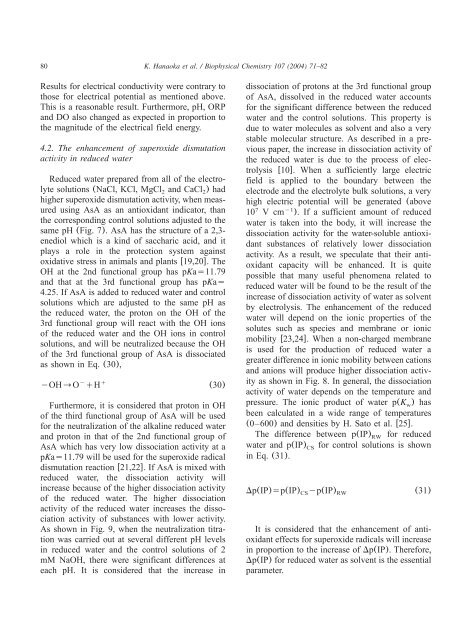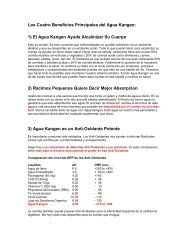ACID-ALKALINE BALANCE: ROLE IN CHRONIC ... - My Kangen Tools
ACID-ALKALINE BALANCE: ROLE IN CHRONIC ... - My Kangen Tools
ACID-ALKALINE BALANCE: ROLE IN CHRONIC ... - My Kangen Tools
You also want an ePaper? Increase the reach of your titles
YUMPU automatically turns print PDFs into web optimized ePapers that Google loves.
80 K. Hanaoka et al. / Biophysical Chemistry 107 (2004) 71–82<br />
Results for electrical conductivity were contrary to<br />
those for electrical potential as mentioned above.<br />
This is a reasonable result. Furthermore, pH, ORP<br />
and DO also changed as expected in proportion to<br />
the magnitude of the electrical field energy.<br />
4.2. The enhancement of superoxide dismutation<br />
activity in reduced water<br />
Reduced water prepared from all of the electrolyte<br />
solutions(NaCl, KCl, MgCl2 and CaCl)had 2<br />
higher superoxide dismutation activity, when measured<br />
using AsA as an antioxidant indicator, than<br />
the corresponding control solutions adjusted to the<br />
same pH(Fig. 7). AsA has the structure of a 2,3-<br />
enediol which is a kind of saccharic acid, and it<br />
plays a role in the protection system against<br />
oxidative stress in animals and plants w19,20x. The<br />
OH at the 2nd functional group has pKas11.79<br />
and that at the 3rd functional group has pKas<br />
4.25. If AsA is added to reduced water and control<br />
solutions which are adjusted to the same pH as<br />
the reduced water, the proton on the OH of the<br />
3rd functional group will react with the OH ions<br />
of the reduced water and the OH ions in control<br />
solutions, and will be neutralized because the OH<br />
of the 3rd functional group of AsA is dissociated<br />
as shown in Eq.(30),<br />
y q<br />
yOHO qH (30)<br />
Furthermore, it is considered that proton in OH<br />
of the third functional group of AsA will be used<br />
for the neutralization of the alkaline reduced water<br />
and proton in that of the 2nd functional group of<br />
AsA which has very low dissociation activity at a<br />
pKas11.79 will be used for the superoxide radical<br />
dismutation reaction w21,22x. If AsA is mixed with<br />
reduced water, the dissociation activity will<br />
increase because of the higher dissociation activity<br />
of the reduced water. The higher dissociation<br />
activity of the reduced water increases the dissociation<br />
activity of substances with lower activity.<br />
As shown in Fig. 9, when the neutralization titration<br />
was carried out at several different pH levels<br />
in reduced water and the control solutions of 2<br />
mM NaOH, there were significant differences at<br />
each pH. It is considered that the increase in<br />
dissociation of protons at the 3rd functional group<br />
of AsA, dissolved in the reduced water accounts<br />
for the significant difference between the reduced<br />
water and the control solutions. This property is<br />
due to water molecules as solvent and also a very<br />
stable molecular structure. As described in a previous<br />
paper, the increase in dissociation activity of<br />
the reduced water is due to the process of electrolysis<br />
w10x. When a sufficiently large electric<br />
field is applied to the boundary between the<br />
electrode and the electrolyte bulk solutions, a very<br />
high electric potential will be generated (above<br />
7 y1<br />
10 V cm ). If a sufficient amount of reduced<br />
water is taken into the body, it will increase the<br />
dissociation activity for the water-soluble antioxidant<br />
substances of relatively lower dissociation<br />
activity. As a result, we speculate that their antioxidant<br />
capacity will be enhanced. It is quite<br />
possible that many useful phenomena related to<br />
reduced water will be found to be the result of the<br />
increase of dissociation activity of water as solvent<br />
by electrolysis. The enhancement of the reduced<br />
water will depend on the ionic properties of the<br />
solutes such as species and membrane or ionic<br />
mobility w23,24x. When a non-charged membrane<br />
is used for the production of reduced water a<br />
greater difference in ionic mobility between cations<br />
and anions will produce higher dissociation activity<br />
as shown in Fig. 8. In general, the dissociation<br />
activity of water depends on the temperature and<br />
pressure. The ionic product of water p(K ) has w<br />
been calculated in a wide range of temperatures<br />
(0–600) and densities by H. Sato et al. w25x.<br />
The difference between p(IP) for reduced<br />
RW<br />
water and p(IP) for control solutions is shown<br />
CS<br />
in Eq.(31).<br />
Dp(IP)sp(IP) CSyp(IP) RW (31)<br />
It is considered that the enhancement of antioxidant<br />
effects for superoxide radicals will increase<br />
in proportion to the increase of Dp(IP). Therefore,<br />
Dp(IP) for reduced water as solvent is the essential<br />
parameter.



